blog
Maximising The Benefit From Your Orthotics with Physical Therapy
December 3, 2017
 Orthotics are one of our specialties here at Perform Podiatry. Our team are not only experts in the biomechanical function of the feet and legs but happen to be the sole teacher of orthotic prescription and creation at New Zealand’s School of Podiatry. Yes, this specialty and the way we use it to improve the lives of our patients is something we are very proud of!
We use orthotics to:
Orthotics are one of our specialties here at Perform Podiatry. Our team are not only experts in the biomechanical function of the feet and legs but happen to be the sole teacher of orthotic prescription and creation at New Zealand’s School of Podiatry. Yes, this specialty and the way we use it to improve the lives of our patients is something we are very proud of!
We use orthotics to:
- Alter the alignment and movement of the lower limbs to reduce pressure on painful muscles, joints, ligaments and bones
- Get the feet and legs functioning optimally to get optimum performance with minimum energy output to keep you going for longer
- Correct any abnormalities in the feet or legs or variances between the lower limbs that are problematic
- Help your feet feel more comfortable so you can feel great, look great, and do the things you love without discomfort
When you start wearing your orthotics, your feet and legs will start to function differently. You may even see some improvement in your upper body, like your spine and the muscles in your back and/or neck. This is, of course, dependant on the purpose of the orthotics you were prescribed. Orthotics are very much like glasses in this sense – they work with you and your body to improve performance. But what can you do to maximise the benefits from your orthotics for your body? Here are 3 great ways to start with physical therapy:
-
Strengthen your body
Strength is your body’s protection. The risk of injury and re-injury is reduced by having strong muscles and joints as your body works like a finely-tuned machine. Strength also enhances and optimises recovery from injury. This is a great compliment to orthotic therapy, especially when your lower limbs will be working at their best in the orthotics. During your biomechanical assessment for your orthotics, your Podiatrist should identify any areas or muscles that are weaker, so make sure to focus on these and their advice on strengthening.
-
Stretch and improve your mobility
If you’ve had a past injury or something wasn’t working quite right (hence the need for orthotics), then there is a good chance you’ll have some imbalance where some muscles may be tight or knotted. Tightness alters the way our body moves and can often be a major contributing factor to injury. Make sure to regularly stretch your feet and legs to get your body feeling and functioning at its best. During your biomechanical assessment for your orthotics, your Podiatrist will also identify areas of particular tightness and give you exercises, so make sure to listen to their advice and follow through.
-
Check your posture
We all know that posture is very important, but it can also greatly affect our lower limbs and our recovery from and outcome of injury. This is because our posture dictates the constant positions of our bones, joints, muscle and ligaments – and whether they’re stretched, strained and suffering from more damage, or not. Getting on top of (or should we say, in line with) our posture helps all of our other structures as our orthotics work to control them.
For any questions on anything we’ve talked about or to book an appointment with our expert team, give us a call on 09 523 2333 and all the best with your recovery!
 Orthotics are one of our specialties here at Perform Podiatry. Our team are not only experts in the biomechanical function of the feet and legs but happen to be the sole teacher of orthotic prescription and creation at New Zealand’s School of Podiatry. Yes, this specialty and the way we use it to improve the lives of our patients is something we are very proud of!
We use orthotics to:
Orthotics are one of our specialties here at Perform Podiatry. Our team are not only experts in the biomechanical function of the feet and legs but happen to be the sole teacher of orthotic prescription and creation at New Zealand’s School of Podiatry. Yes, this specialty and the way we use it to improve the lives of our patients is something we are very proud of!
We use orthotics to:
